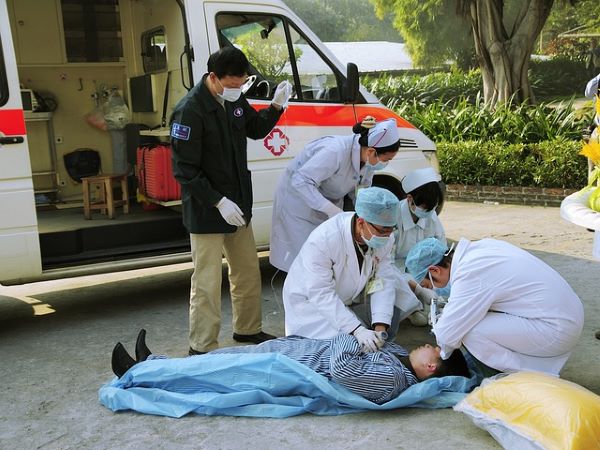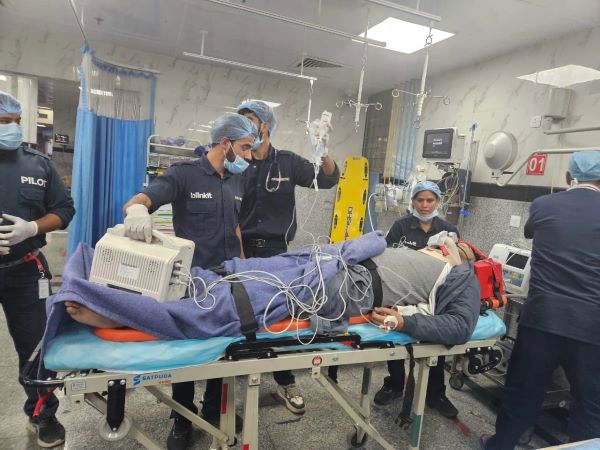The world of healthcare is changing fast, and sometimes, you come across an idea so brilliant that you just know it’s going to be a game-changer. Recently, Prof. Deepak Agrawal from AIIMS shared an experience on LinkedIn that had everyone talking. He highlighted how a Blinkit ambulance service brought in a patient with top-notch pre-hospital emergency care, something we usually see in developed nations. The paramedic team followed all essential trauma protocols, ensuring the patient arrived in a stabilized condition.
Now, imagine if we took this a step further. What if emergency care could be delivered in 10 minutes—with the ambulance that arrives or perhaps something else? Picture this: a heart attack, a severe stroke, or a road accident victim in dire need of life-saving medication. Instead of waiting for an ambulance, what if a motorbike, drone, or even a hyper-prioritized delivery van could rush emergency kits to the location within minutes?
Sounds futuristic? Maybe. But possible? Absolutely.
Why This Idea of 10-Minute Pre-Hospital Emergency Care Could Save Lives
Time is everything in a medical emergency. There’s a reason why doctors talk about the Golden Hour—the critical time frame where immediate intervention can mean the difference between life and death. Here’s how a 10-minute emergency care delivery system could completely change the game:
- Stroke & Paralysis: Administering clot-busting drugs within the first few minutes can prevent permanent damage.
- Cardiac Arrest: If CPR assistance and an automated defibrillator arrive early, survival chances can go up dramatically.
- Severe Bleeding (Accidents & Trauma): Medications like Tranexamic Acid can reduce mortality rates significantly.
- Seizures & Epilepsy Attacks: Quick access to anti-seizure medications can prevent brain damage.
- Severe Allergic Reactions (Anaphylaxis): A pre-filled Epipen or adrenaline shot can save a life within minutes.
We’re talking about a system that can fill the gap between the emergency and the ambulance’s arrival.
How 10-Minute Pre-Hospital Emergency Care Could Work?
Building a 10-minute emergency care delivery system requires some critical steps, but the good news is—India already has the infrastructure for it!
1. Approval & Stocking Emergency Kits
- Medical regulators need to approve certain life-saving medications for rapid delivery.
- Local pharmacies, hospitals, and online delivery services should stock and distribute these kits strategically.
Also Read: Now Know 10 Best Government Hospitals in Kolkata
2. Emergency Checkout in Delivery Apps
- Create a dedicated emergency section in apps like Blinkit, Zepto, or Swiggy Instamart.
- Allow super-fast checkout (perhaps a single-tap process) with COD or UPI payment options.
- Train delivery personnel in basic first aid for critical cases.
Also Read: Quickly Know Now All About First Aid For Foodborne Illness
3. Prioritization Over Everything Else
- Orders labeled as “Medical Emergency” should override all other deliveries.
- Instead of waiting for routine batching, an emergency bike fleet or drones should dispatch the order immediately.
Also Read: Clinic’ medical consultation service in India
4. Partnering With National Highways Authority of India (NHAI)
- Accidents on highways account for thousands of deaths every year.
- If such a system is implemented on highways, emergency kits could reach victims faster than ambulances.
- Blinkit or similar services could partner with NHAI to deploy emergency medicine stocks at toll booths or highway checkpoints.
Think about how many lives this could save in rural areas or on long highway stretches where ambulances take longer to reach.
Challenges & The Road Ahead
Of course, implementing such a system wouldn’t be easy. Here are a few hurdles that need to be tackled:
- Regulatory Approvals: Government medical bodies would need to allow certain prescription drugs for emergency delivery.
- Training Delivery Agents: While they wouldn’t be administering medication, they’d need basic training on handling medical kits.
- Liability & Legal Issues: Companies would need clear protocols on who is responsible if something goes wrong.
- Logistics & Infrastructure: Emergency kits would need to be strategically stocked in key locations for rapid dispatch.
But here’s the thing—every revolutionary idea comes with challenges. It’s about finding solutions, not stopping at problems.

Why 10-Min Emergency Care Is The Healthcare Revolution India Has Been Waiting For?
Emergency healthcare in India has long been in need of speed, efficiency, and accessibility. With platforms like Blinkit proving that rapid emergency services are possible, it’s time to think bigger.
If Quick Commerce Companies can deliver your phone charger in 10 minutes, why can’t we do the same for life-saving medication?
Imagine a future where:
- Someone having a stroke gets clot-busting drugs before an ambulance arrives.
- A road accident victim gets a bleeding control kit at the scene.
- A person with severe asthma receives a nebulizer in minutes.
These aren’t just hypothetical scenarios—they’re possible today with the right vision and execution.
Final Thoughts: The Time Is NOW
This idea isn’t about replacing ambulances—it’s about supporting them. It’s about filling a critical time gap where immediate intervention can mean life or death.
Companies like Blinkit, Zepto, and Swiggy Instamart have already built the logistics. Now, they just need to think beyond groceries. The government, NHAI, and private healthcare players need to come together and make this happen.
It’s a no-brainer, really.
10-minute pre-hospital emergency care isn’t just an idea—it’s the future of healthcare in India. Let’s make it happen.

Image Courtesy: Prof Deepak Agrawal via LinkedIn.




